Clarke Meg Soprano D whistle Review
(Review written January 2006)
- Preface
-
The Clarke Tinwhistle Company was started in 1843 by Robert Clarke. The traditional Clarke whistle you can buy made of rolled tinplate with a wood block fipple is made in essentially the same way as the originals in 1843. The Clarke Sweetone is a more modern verson of the Clarke whistle, using the same basic body construction of rolled and sealed tinplate, but with a modern, plastic mouthpiece designed by Michael Copeland (of Copeland Whistles). It made it's appearance in 1996, and I got one right away. To tell you the truth, the Sweetone was the biggest factor in my continued whistle practice at the time. I was a little frustrated with the Clarke original I had. It took a lot of air, and I was still a cigarette smoker back then. So, I got a Shaw (big mistake!) because there wasn't any resources to tell me that Shaws took even more air than Clarkes! When I finally got a Sweetone, I was in heaven!
The Meg, introduced in 2002, is a lower-cost version of the Sweetone--the same molds and construction methods are used, but the Clarke company takes advantage of cheaper labor and materials overseas to produce a cheaper instrument. I've read reports of inconsistency among them, but since these came out, I've owned and given away perhaps a half-dozen of them, gotten in various ways (bought from different stores, gotten as part of trades, etc) and all of those have been consistent in make and quality.
For that reason, I am not going wax poetic talking about the playing characteristics of this whistle. For all intents and purposes, if you know a Sweetone or read my Sweetone review, you know this whistle. I've never gotten an iffy one, but have read one or two stories about people who have, so take that for what it's worth.
- At a Glance
- Whistle Reviewed
- Clarke Meg Soprano D whistle
- Models Available
- C and D in a variety of colors
- How Acquired
- Acquired secondhand
- Construction
- Rolled tinplate with a plastic mouthpiece.
- Price at Time of Review (in US Dollars unless otherwise noted)
- approx $3.00
- Available From
-
Lark in the Morning (be warned that Lark seriously overcharges for Megs)
The Whistle Shop And many more
- Appearance
- There's not a lot to say about the construction of this whistle that hasn't already been said about the Clarke Sweetone. The construction is identical, and in fact may be a little better. The plastic head on the meg is slightly better molded, with less of a molding "lip" along the side of the head. The material itself looks slightly different, with smaller "pores"--the plastic used for both of the Sweetone and the Meg's heads are not shiny-slick but rather has extremely fine texture. The Sweetone head is a little darker black plastic.
-
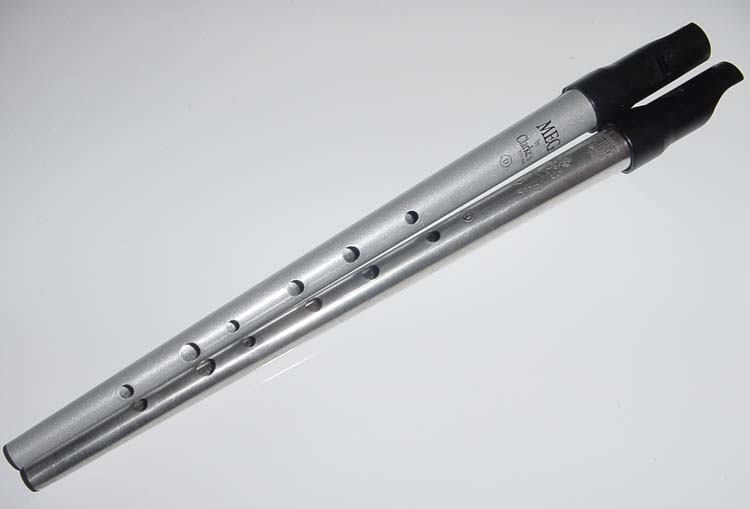
Here's the full whistle. Other than the Meg logo, it's identical to a Sweetone. In all of these pictures, I'm including a Sweetone for comparison. The silver whistle is the Meg, while the unfinished whistle is the Sweetone.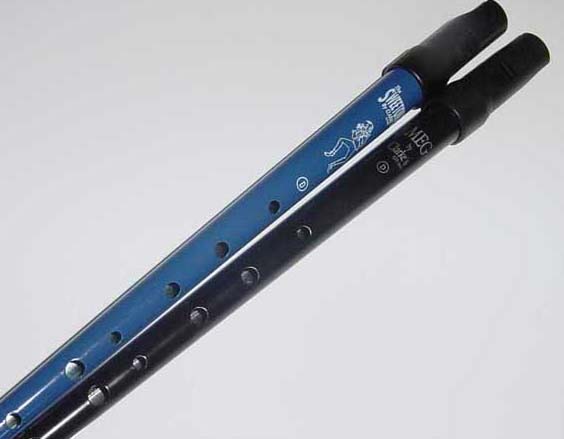
These things come in a variety of colors. I've owned a few of each, and they're all pretty much identical. I end up giving them away to people, and buying more, since they're so darn cheap. I started this review 3 months ago, but I had to wait to replace these whistles, because I gave the Sweetone above to a co-worker and the Meg to a kid who seemed enamored of my playing. That's right. I'm a whistle pusher.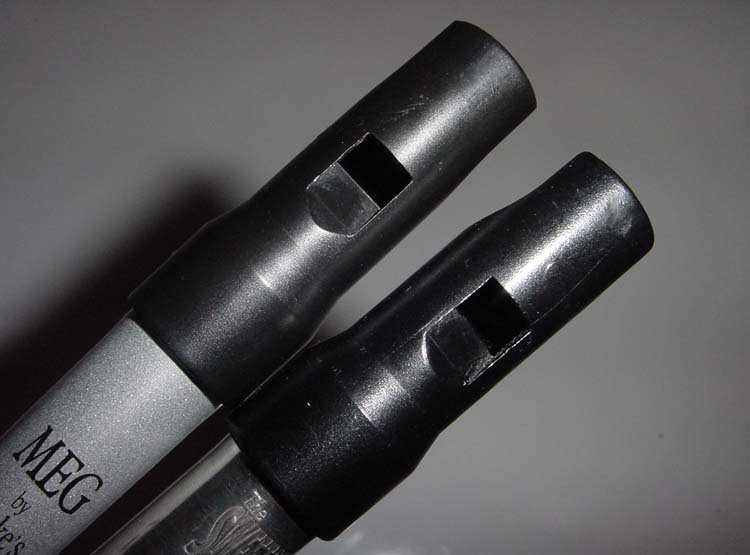
Here's a close-up of the mouthpiece. Yeah, that's a little tooth mark there on the Sweetone. I don't know what it is about this mouthpiece design that mkes me want to grip it in my teeth when no other mouthpiece does.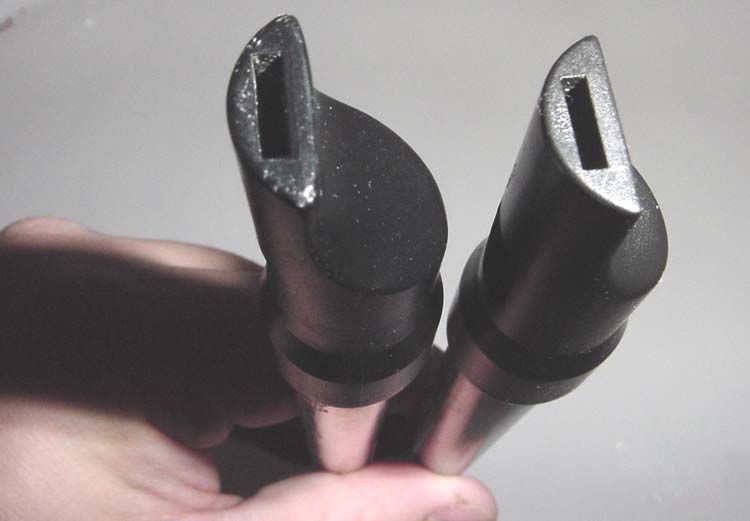
Here's another angle on the mouthpiece, showing the fipple area. Note that on the Sweetone the mouthpiece is held on with glue, I beleive, because it takes a lot of work to get these to budge. On the Meg, the only thing holding it on is friction...so it's tunable right out of the box. Sweet!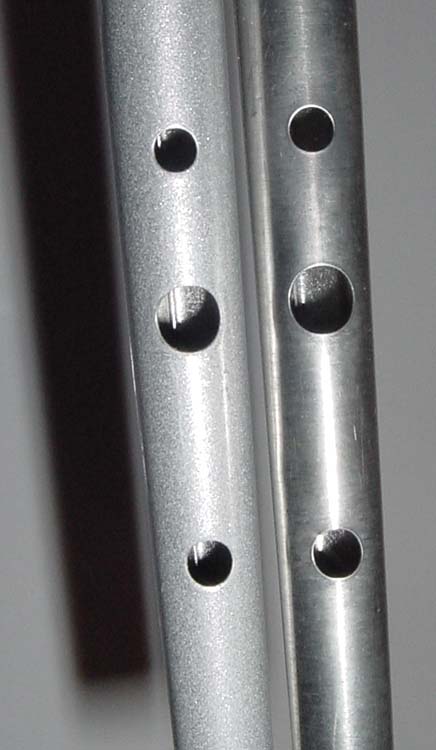
A shot at the end of the whistle, showing the last three holes.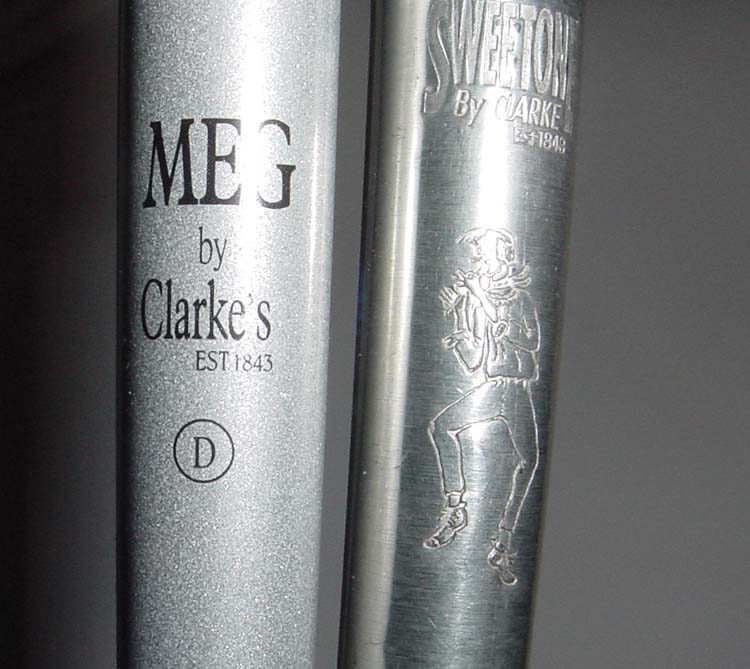
The Meg and Sweetone logos.
- Playing Characteristics
- Again, all the Megs I've owned have been identical to the Sweetones I've owned. And I've owned around half a dozen of each of them. Mellow, hollow-flutey sounding, easy playing and not too piercing in the second octave. Sweetones have a very distinctive sound..and that sound is shared by the Meg.
-
Sound clips of the whistle:
Rakes of MallowVolume: Low side of medium, same as a Sweetone.
Responsiveness: Moderate, same as a Sweetone. The tone of this instrument keeps my fastest ornaments from sounding crisp.
Tuning: In tune across it's entire range, same as a Sweetone.
C-natural: OXXOOO produces an in-tune c-natural.
Hole size and placement: This whistle has holes are average size and placement.
Air volume requirements: Low side of medium.
Air pressure requirements: medum low. Like the sweetone, this is a very easy player both in terms of breath pressure and air needed. It doesn't take much effort, even at the top of it's range.
Clogging: About the same as a Sweetone: Starts clogging in about 20 minutes. Duponol helps.
Wind Resistance: Medium. Good breezes knock this out, and I have to do the wind dance (where you shuffle around while playing to try to keep the wind at your back) more than I'd like, but still, I've been able to play this outside with some success.
- Summary
- Some people don't care for the tone of a Sweetone. If that's the case, you won't like the Meg any better. But for many, this is a fine instrument, and a great beginner's instrument. It's so inexpensive, you could even give them out as presents or party favors to children, in the hopes that one of them takes to the whistle.